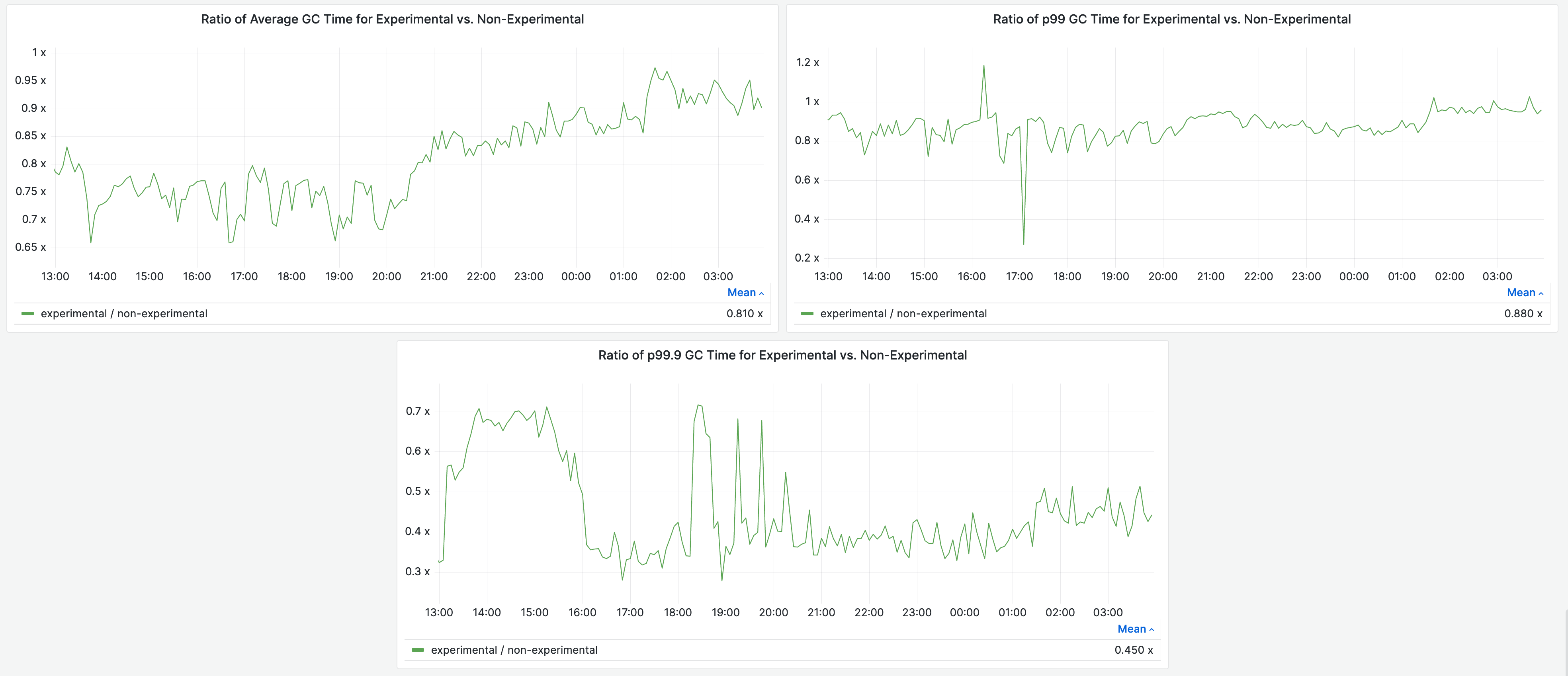Feature #19610
closedGC.delay_promotion
Description
GitHub Pull Request: https://github.com/ruby/ruby/pull/7683
I'm proposing GC.delay_promotion, which is a feature that changes characteristics of the garbage collector.
When set to false (the default value), the GC keeps the original behavior. This means that references from an old object to a write barrier protected young object will immediately promote the young object. References from an old object to a write barrier unprotected object will place the write barrier unprotected object in the remember set for marking during minor collections.
When set to true, references from an old object to a write barrier protected young object will not immediately promote the young object. Instead, the young object will age just like any other object, meaning that it has to survive three collections before being promoted to the old generation. References from an old object to a write barrier unprotected object will place the parent object in the remember set for marking during minor collections. This allows the child object to be reclaimed in minor collections at the cost of increased time for minor collections.
On one of Shopify's highest traffic Ruby apps, Storefront Renderer, we saw significant improvements after deploying this feature in production. In the graphs below, we compare the GC time and response time of web workers that have GC.delay_promotion = false (non-experimental group) and GC.delay_promotion = true (experimental group). We see that with this feature we spend significantly less time in the GC, 0.81x on average, 0.88x on p99, and 0.45x on p99.9.

This translates to improvements in average response time (0.96x) and p99 response time (0.92x).

In benchmarks, this feature performs better in some scenarios and worse in others. However, these benchmarks are usually not a good indicator as there are few old objects and major collections are not a significant bottleneck.
-------------- ----------- ---------- --------- ----------- ---------- --------- -------------- -------------
bench master (ms) stddev (%) RSS (MiB) branch (ms) stddev (%) RSS (MiB) branch 1st itr master/branch
activerecord 70.7 0.2 54.4 70.5 0.3 54.7 1.01 1.00
erubi_rails 20.5 2.0 103.0 20.7 2.2 102.2 0.94 0.99
hexapdf 2470.1 0.3 275.6 2475.4 0.7 215.9 1.03 1.00
liquid-c 65.2 1.4 39.8 65.4 0.3 39.7 1.05 1.00
liquid-compile 59.5 3.4 38.9 57.5 3.0 38.3 0.99 1.04
liquid-render 164.3 1.1 36.1 159.8 0.2 35.5 1.02 1.03
mail 135.7 0.2 50.2 135.3 0.1 50.0 1.00 1.00
psych-load 2053.0 0.0 36.4 2003.3 0.1 35.3 1.03 1.02
railsbench 2001.8 0.7 107.1 1965.1 0.0 107.3 1.00 1.02
ruby-lsp 67.1 8.7 94.6 65.1 0.8 92.8 0.97 1.03
sequel 72.4 0.2 40.4 71.3 0.2 40.4 1.01 1.02
-------------- ----------- ---------- --------- ----------- ---------- --------- -------------- -------------
Files
 Updated by byroot (Jean Boussier) over 2 years ago
Updated by byroot (Jean Boussier) over 2 years ago
Is there really a substantial benefit in putting it behind a flag?
From my understanding, old objects for the most part are assumed stable, so promoting young objects early make minor GC a bit faster during boot, but that's about it.
I'd be in favor of just making this the new behavior.
 Updated by peterzhu2118 (Peter Zhu) over 2 years ago
Updated by peterzhu2118 (Peter Zhu) over 2 years ago
I think this will be beneficial to most Rails apps (and probably most workloads in general), so I do agree that it would be a good idea to enable this by default and possibly make this the only option (and that way we don't need to introduce a new API).
 Updated by ko1 (Koichi Sasada) over 2 years ago
Updated by ko1 (Koichi Sasada) over 2 years ago
On my understanding, this proposal is for an object which are marked by an old object, and do not promote it immediately but increment age of the object. remember set (bitmap) keeps to refer this object and next minor GC marks this object again.
If this object is not so long living (for example, surviving 1 GC, but dead before 2nd GC), it can affect.
If this object has long lifetime (> 4 GCs), it doesn't affect.
- Pros.
- old objects will be reduced.
- major GC counts will be reduced because of
- Cons.
- minor GC can increase marking time because of remembered objects.
If my understanding is correct, can we measure some values (major GC counts per minor GC and so on?) to proof that?
 Updated by byroot (Jean Boussier) over 2 years ago
Updated by byroot (Jean Boussier) over 2 years ago
If my understanding is correct,
It is.
can we measure some values (major GC counts per minor GC and so on?) to proof that?
We won't be able to get that data in time for the developer meeting but we could probably get it in a week or two.]
However I think the graphs of time spent in GC @peterzhu2118 (Peter Zhu) posted are a decent proxy of that.
 Updated by peterzhu2118 (Peter Zhu) over 2 years ago
Updated by peterzhu2118 (Peter Zhu) over 2 years ago
In the developer meeting in Matsumoto, we discussed this ticket. We agreed that making this feature configurable makes the GC harder to use and leaked too many implementation details. We decided to instead make this feature always enabled.
I opened https://github.com/ruby/ruby/pull/7821 as an alternative where this feature is always enabled.
 Updated by byroot (Jean Boussier) over 2 years ago
Updated by byroot (Jean Boussier) over 2 years ago
Should we edit the title or open another ticket?
 Updated by peterzhu2118 (Peter Zhu) over 2 years ago
Updated by peterzhu2118 (Peter Zhu) over 2 years ago
I opened #19678.
 Updated by byroot (Jean Boussier) over 2 years ago
Updated by byroot (Jean Boussier) over 2 years ago
- Related to Feature #19678: Don't immediately promote children of old objects added
 Updated by byroot (Jean Boussier) over 2 years ago
Updated by byroot (Jean Boussier) over 2 years ago
- Status changed from Open to Rejected
Ok, closing in favor of #19678 then.